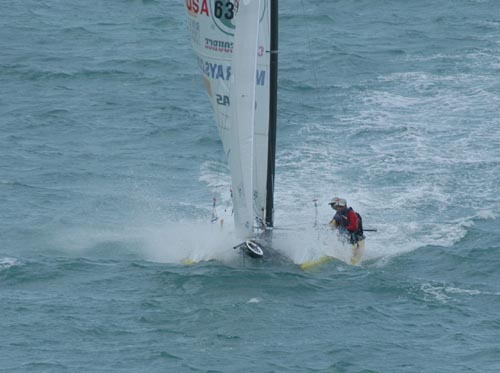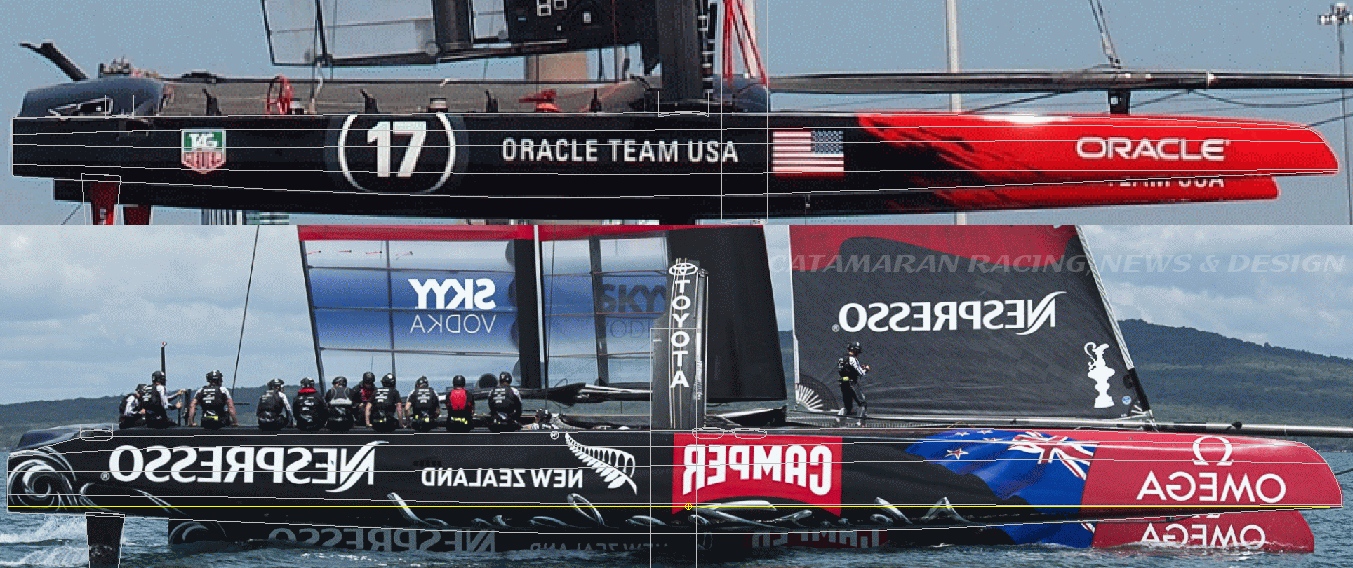I’ve noticed several things in the current America’s Cup finals that keep my interest. While others in San Francisco seem completely oblivious to the racing, and it’s hard to drag them out and watch, I’m still excited about watching these points:
- Overall performance (energy transfer) engineering: ETNZ has the best boat design engineers in the world. It’s clear. They’re getting 4-5 knots more speed upwind. That is a huge factor for match competition where getting on top of the other boat means controlling the finish — the deciding factor in several races so far. I’ve seen far more twist at the top of the ETNZ sail compared to Oracle. Basically, Oracle spent more than double yet ended up with a slower boat. A straight run speed delta also tends to have a serious psychological effect on the sailors, forcing other errors, because it’s hard to stay positive when side-by-side you fall behind.
- Reduced drag: Both teams position sailors further and further below deck level. One of the team engineers told me that one single sailor standing up causes enough drag at 25knts to impact performance by several seconds a kilometer. The boats are only a few seconds apart in the races so over a 1500m course a boat with less drag from sailors themselves will have a measurable advantage. ETNZ seems to have the more aerodynamic deck and cowlings. It also hurts when water hits you at 25knts (like cold nails) so working lower is probably welcome relief.
- Turns: As the boats jockey for dominance they carve incredibly fast turns. A 72ft boat that can pivot at speed within its own waterline is a phenomenal engineering achievement. The wind and water generate massive loads yet the captains clearly transfer the energy and shift quickly while keeping speed. ETNZ has an advantage in this area as they clearly make smoother turns and maintain more of their speed, which further capitalizes on straight-line speeds.
- Team fitness: These people have trained non-stop for three years, every day and often twice a day. They are at the peak of physical shape. Yet when I watch the videos with sound on I hear them wheezing and coughing as if they can barely catch their breath. Turning and tuning the boat completely maxes them out. And they can’t go anywhere. Unlike football, soccer, basketball, baseball, volleyball…there is no relief or substitution possible. The Round-the-World Ocean races once were described to me as playing rugby without any option of leaving. That is why professional sailing could perhaps be seen as one of the top physically demanding sports in the world.
- Tactics: I’m completely shocked at the errors a usually ultra-aggressive Spithill has made. I expected to see Oracle try and force errors, play dirty and get in Barker’s face at every chance. Instead Spithill has made repeated unforced errors and been charitably giving away races. Perhaps he is not in sync with his team, or the speed delta is getting into his head. When the match-racing heat is on high, Spithill starts melting and makes moves painful to watch. Meanwhile Barker, always the quiet gentleman, sails away confidently and cleanly.
- Team Nationality: Spithill almost made me spit up when I first saw him tell an audience Oracle is the “home team”. This man is an Aussie through-and-through. Nothing wrong with that, but he has stated in interviews that ever since 1983 (when he saw Australia win the cup) he has dedicated his life to Australia keeping the cup. In the post-race interview a few days ago he repeated his “home team” nonsense and said ETNZ is trying to “take the cup far away”. Barker, in a beautifully accurate retort said “if we win we’ll bring it closer to your home”. Indeed, Spithill might prefer a NZ win.
Spithill thus comes across as awkward as if forced to ask for support now from the country he has loved to hate as a sailor. In addition, despite being in America, Oracle also has a reputation for disdain towards its home country and especially the cities lived-in by Ellison. A real-estate agent just told me the Oracle CEO bought a house in SF to watch the races and immediately demanded the neighbor, an elderly lady in retirement, cut down her trees so he could get a better view. She said no at first, since they were clearly on her property. Then Oracle lawyers promptly arrived and asked her if she really, really wanted them to wipe out all her retirement money in a messy legal fight and leave her for dead. With a home team like that who needs enemies?
ETNZ, in stark comparison, has used a large percentage of funds direct (kick-started) from their government and held discussion about how the money spent will benefit taxpayers (jobs, business, trade, etc.).
- Boat Nationality: Both boats were built in New Zealand, which if advertised more might help recoup some of the national investment. More interesting than that, however, is the ETNZ boat was designed by the American team that won the cup back from NZ in 1988 with a catamaran. So the ETNZ boat is essentially a successor American boat to the 1988 campaign, while the Oracle boat is apparently not American at all. It may even be French, since they have boasted about finding their initial wing designer in France. Whatever the Oracle boat is or isn’t, to me ETNZ is really sailing the American boat design.
- Waterfront access for dinghies: Perhaps the most annoying fact of the entire event is that it is inaccessible to the common person. Super-yachts need more berthing space about as much as anyone needs a hole in the head. Those who aren’t billionaires, on the other hand, really REALLY need a place to launch a performance dinghy in San Francisco. Basically if you’re a kid in an Optimist you’re ok because clubs will support that but once you graduate to something fun where do you go? And if you’re a young professional ready to splash down some money and go for a hot ride…you basically can’t unless you go far away. The waterfront has no facilities and no support. None. That is perhaps the biggest oversight of this entire event. Even rockets are more accessible than high performance dinghy sailing to people who live in SF.
Those are some of the major notes. In summary, ahead I see a sea-change in the boat-building industry and very little change in the American sailing community. Globally we’ll get more efficient, faster and more fun boats of all sizes yet unfortunately this will not lead to any more American kids rushing to get into sailing.
I have a bunch more items I’m tracking but just wanted to share the biggest and most recent ones. Let me know if you have others to add or discuss.




